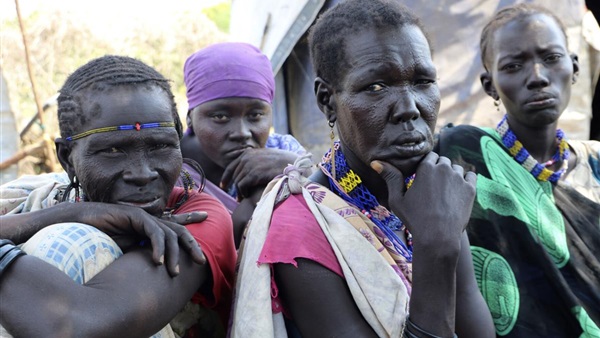Thousands in South Sudan near famine

After nearly a week of hiding from conflict, Kallayn
Keneng watched two of her young children die. “They cried and cried and said,
‘Mom, we need food,’” she said. But she had nothing to give. Too frail to bury
her 5-year-old and 7-year-old after days without eating, she covered their
bodies with grass and left them in the forest.
Now the mourning 40-year-old awaits food aid, one of
more than 30,000 people said to be in likely famine in South Sudan’s Pibor
county. The new finding by international food security experts means this could
be the first part of the world in famine since one was declared in 2017 in
another part of the country then deep in civil war.
South Sudan is one of four countries with areas that
could slip into famine, the United Nations has warned, along with Yemen,
Burkina Faso and northeastern Nigeria.
Pibor county this year has seen deadly local
violence and unprecedented flooding that have hurt aid efforts. On a visit to
the town of Lekuangole this month, seven families told The Associated Press
that 13 of their children starved to death between February and November.
The head of Lekuangole’s government, Peter Golu,
said he received unprecedented reports from community leaders that 17 children
had died from hunger there and in surrounding villages between September and
December.
The Famine Review Committee’s report, released this
month by the Integrated Food Security Phase Classification, stops short of
declaring famine because of insufficient data. But famine is thought to be
occurring, meaning at least 20% of households face extreme food gaps and at
least 30% of children are acutely malnourished.
But South Sudan’s government is not endorsing the
report’s findings. If a famine were occurring it would be seen as a failure, it
says.
“They are making assumptions. … We are here dealing
with facts, they are not on the ground,” said John Pangech, the chair of South
Sudan’s food security committee. The government says 11,000 people across the
country are on the brink of starvation — far less than the 105,000 estimated by
the new report by food security experts.
The government also expects that 60% of the
country’s population, or some 7 million people, could face extreme hunger next
year, with the hardest hit areas in Warrap, Jonglei and Northern Bahr el Ghazal
states.
South Sudan has been struggling to recover from a
five-year civil war. Food security experts say the magnitude of the hunger
crisis has been mostly created by the fighting. That includes bouts of violence
this year between communities with alleged support from the government and
opposition.
The government “is not only denying the severity of
what is happening but is denying the basic fact that its own policies and
military tactics are responsible,” said Alex de Waal, author of “Mass
Starvation: The History and Future of Famine” and executive director of the
World Peace Foundation.
More than 2,000 people have been killed this year in
localized violence that’s been “weaponized” by people acting in their own
interests, the head of the U.N. mission in South Sudan, David Shearer, has
said. Violence has prevented people from cultivating, blocked supply routes,
burned down markets and killed aid workers.
Families in Lekuangole said their crops were
destroyed by the fighting. They now subsist on leaves and fruits.
During violence in July, Kidrich Korok’s 9-year-old
son Martin became separated from the family and spent more than a week in the
forest. By the time he was found, severely malnourished, it was too late.
“He would always tell me that he’d study hard and do
something good for me when he grew up,” Korok said, weeping. “Even while he was
dying, he kept reassuring me that I shouldn’t worry.”
Staff at the health clinic in Lekuangole registered
20 severely malnourished children in the first week and a half of December,
more than five times the number of cases for the same period last year, said a
nurse, Gabriel Gogol.
Flooding has cut off most road access to Pibor town
and its better medical care, forcing some severely sick children to travel for
three days along the river in flimsy plastic rafts.
Officials in Pibor county say they don’t understand
why South Sudan’s government isn’t acknowledging the scale of the hunger.
“If people are saying in (the capital) that there’s
no famine in Pibor, they’re lying and want people to die,” said David Langole
Varo, who works for the humanitarian arm of the government in the Greater Pibor
Administrative Area.
In Pibor town, malnourished mothers and children
wait for hours outside health clinics, hoping for food.
In a joint statement last week, three U.N. agencies
called for immediate access to parts of Pibor county where people were facing
catastrophic levels of hunger.
The World Food Program has faced challenges in
delivering aid this year. Approximately 635 metric tons of food were stolen
from Pibor county and Jonglei state, enough to feed 72,000 people, and an air
drop of food in Lekuangole killed an elderly woman in October.
The WFP said it needs more than $470 million over
the next six months to address the hunger crisis.
Families now worry about a resurgence in fighting as
the dry season approaches.
Sitting in a clinic run by Doctors Without Borders
in Pibor town, Elizabeth Girosdh watched her 8-month old twins fight over her
breast milk. The 45-year-old lost her crops during fighting in her village of
Verteth in June. One of the twins is severely malnourished.
“Sometimes I try to breastfeed but I can’t and the
kids cry and cry all night,” she said. “If there’s not enough food, I worry I
could lose them.”





